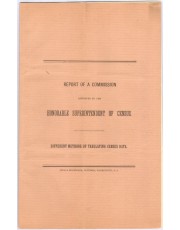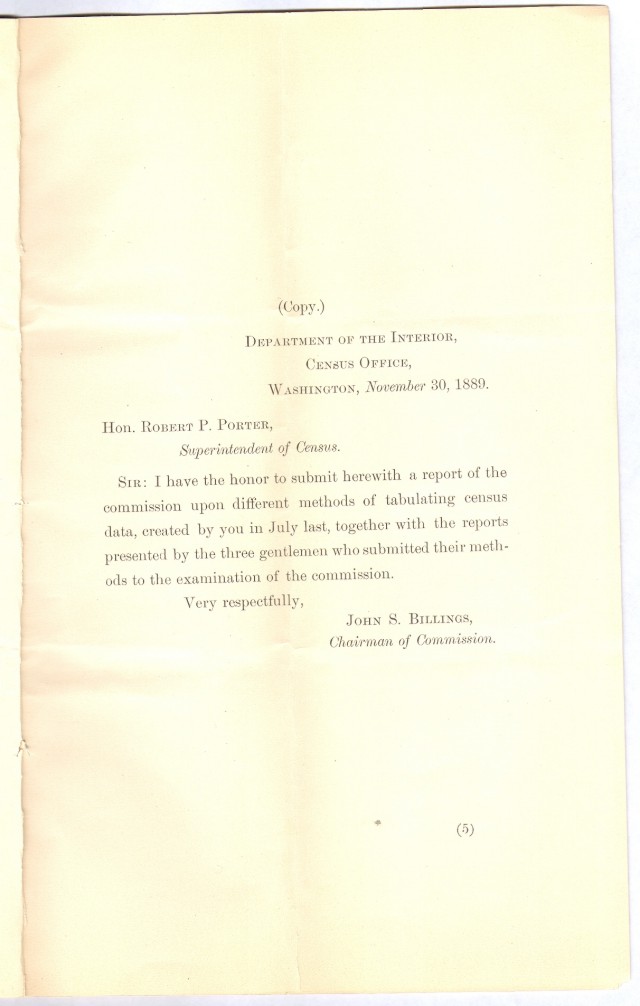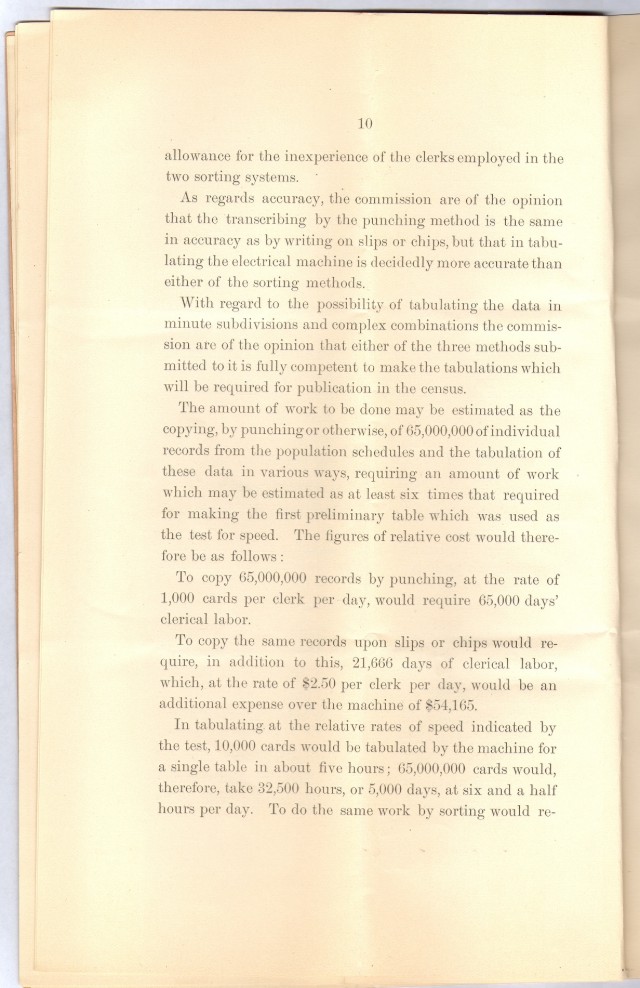 |
We are brick & mortar now!!
Visit us in Parkesburg, PA For more info: www.TheComputerChurch.org (This site no longer maintained.) |
FEATURES
What was the first personal computer?
Coming Soon
Different Methods of Tabulating Census Data

Herman Hollerith's Electric Tabulating System is generally regarded as the beginning of electronic computing in this country. This document, with the typically long governmental title "Report of the Commission Appointed By The Honorable Superintendent Of The Census. Different Methods of Tabulating Census Data." was the basis upon which the contract for the 1890 Census was awarded to Hollerith.
The Commission tested three different methods and Hollerith's was by far the best. After running a test consisting of data from four districts in St. Louis (raw data taken from the previous census), the Hollerith method proved to be considerably faster in both the transcribing phase and in the tabulating phase. (see figures below)
All three methods used individual cards, each of which represented one person. Hollerith's method was to punch holes in the cards to store the information and then to read and tabulate the cards using his Electric Tabulating machine. A second method, offered by Mr. Hunt, involved writing information on cards using colored inks and a third method, offered by Mr. Pidgin, involved writing information on colored cards. Both of those methods used hand sorting to tabulate the data. The test results were as follows:
The Commission tested three different methods and Hollerith's was by far the best. After running a test consisting of data from four districts in St. Louis (raw data taken from the previous census), the Hollerith method proved to be considerably faster in both the transcribing phase and in the tabulating phase. (see figures below)
All three methods used individual cards, each of which represented one person. Hollerith's method was to punch holes in the cards to store the information and then to read and tabulate the cards using his Electric Tabulating machine. A second method, offered by Mr. Hunt, involved writing information on cards using colored inks and a third method, offered by Mr. Pidgin, involved writing information on colored cards. Both of those methods used hand sorting to tabulate the data. The test results were as follows:
| TRANSCRIBING PHASE: | TABULATING PHASE: |
| Hollerith's method -- 72 hours 27 minutes | Hollerith's method -- 5 hours 28 minutes |
| Pidgin's method -- 110 hours 56 minutes | Pidgin's method -- 44 hours 41 minutes |
| Hunt's method -- 144 hours 25 minutes | Hunt's method -- 55 hours 22 minutes |
Related Items
Related Item 1: Author's Edition: An Electric Tabulating System|
Copyright © 2024 by Early Computers Project, All Rights Reserved. |
COMPUTER COLLECTION LIST (PRE-1981)
(Analogs in blue)
(Analogs in blue)
- AIM-65 (single board)
- AIM-65 (factory case)
- AIM-65 (Jon Titus)
- ALICE micro-ordinateur
- Altair 680
- Altair 8800
- Altair 8800A
- Altair 8800b
- Altair 8800b Turnkey (see Pertec below)
- Altair 8800b (see Pertec below)
- Altair 8800b w/ Hardisk Controller & Datakeeper
- Altos ACS-8000
- American Basic Science Club Analog Computer
- AMF Educational Computer
- Apple II Plus
- ASCI SystemX
- ASR 33 Teletype
- Automatic Teaching Computer Kit
- Beckman ElectroComp Electric Heating Computer
- Beckman ElectroComp Energy Savings Computer
- Beckman Solid State Fuel Cost Computer
- Brainiac K-30
- Calif. Computer Systems 2200
- CES Ed-Lab 650
- Commodore 8032
- Commodore 64
- Commodore PET 2001
- Commodore Super Pet
- Compucolor II
- Compukit 1
- Compukit 1 Deluxe Model
- Compukit 2
- Compukit UK101
- Comspace CT-650
- Cosmac Elf (RCA1802)
- Cosmac Microtutor
- Cosmac Netronics ELF II
- Cosmac VIP
- Cromemco System I
- Cromemco System III
- Cromemco Z-2D
- Datapoint 2200
- Digi-Comp I (flat box)
- Digi-Comp I (square box)
- Digital Computer Lab
- Donner 3500
- Durango F-85
- Dynabyte
- E & L Inst MMD-1
- E & L Inst MMD-2
- Eagle II
- Electric Tabulating Machine (one original counter, 1889)
- Electronic Associates TR-10
- Electronic Associates TR-10 Model II
- Electronic Associates TR-20
- Electronic Associates TR-48
- Electronic Associates Model 180
- Electronic Associates Model 380 Hybrid
- Geniac
- Google Glass (definitely not vintage)
- Heath EC-1 (factory assembled by Heath)
- Heathkit EC-1 (kit)
- Heathkit ET 3100 trainer
- Heathkit H8
- Heathkit H9 Video Terminal
- Hickok Logic Teaching Sys.
- Hickok Servo Teaching Sys.
- HP 2115A
- HP 85
- HP 5036A
- HP 9825A
- HP 9825B
- HP 9830A
- Iasis 7301
- I-COR MAC-1
- ICS Microcomputer Training System
- IMSAI 108 (prototype)
- IMSAI 8048 Control Computer
- IMSAI 8048 (The Dollhouse Computer)
- IMSAI 8080
- IMSAI PCS-40
- IMSAI PCS-80
- IMSAI VDP-80
- Informer
- Intel Intellec MDS
- Intel MDS-800
- Intel Prompt 48
- Intel SBC 80/10
- Intel SDK-85
- Intel SDK-85 (unassembled)
- Intel SDK-86
- Intertec Superbrain
- ITT MP-EX
- JR-01 Computer
- KIM-1
- LAN-DEC
- LAN-DEC 20
- LAN-ALOG
- Lehrcomputer (Germany)
- Lawrence Livermore Lab
- Lear Siegler ADM3A
- Logikit LK255 (Feedback)
- Logix SF-5000 Electronic Computer
- MAC-1 Mini Analog Computer
- MAC Tutor (Bell Laboratories)
- MEK6800D2
- Micro 68
- Microtan 65
- Midwest Scientific Instruments 6800
- Minivac 601
- Minivac 6010
- Mini-Scamp Microcomputer
- Nascom I
- Nascom II
- National Radio Institute 832
- NEC TK-80
- NorthStar Horizon
- Olivetti Programma 101
- Olivetti Programma 203
- Olivetti Programma 602
- Open University PT501
- Ordinateur d'Apprentissage JR-01
- Osborne 1
- OSI 300
- OSI 600 (SuperBoard II)
- OSI C2-OEM-4
- OSI Challenger-1P
- Pastoriza Personal Analogue Computer
- Pertec MITS 300/25 (Altair desk business system)
- Pertec MITS 300/55 (Altair Turnkey business system)
- PolyMorphic Systems 8810
- PolyMorphic Poly-88
- Protech-83
- Range Keeper Mk.6 Mechanical Analog Computer, 1926
- Range Keeper Mk.7 Mechanical Analog Computer, 1935?
- Sargent-Welch Scientific Company Cat. No.7528 Analog Computer
- Science of Cambridge MK-14 (Sinclair)
- SD Systems Z80 starter kit
- Sharp MZ-40K
- Sharp MZ-80k
- Siemens ECB-85
- Signetics Instructor 50
- Sinclair ZX-81
- Smoke Signal Broadcasting
- Sol-20
- Spark16
- Sphere 1
- Sphere/SWTPC Computer System
- SWTP CMOS Microlab
- SWTP CT-82 Terminal
- SWTPC 6800
- SWTPC 6800 (w/ Smoke Signal Broadcasting drive)
- SWTPC CT-64 Video Terminal, SS-50
- SWTPC TV Typewriter II CT-1024
- Synertek VIM-1
- Synertek SYM-1
- Systron-Donner 3500
- Tei MCS-112
- Tektronix 4006-1
- Telefunken RAT 700
- TI LCM-1001 (Microprogrammer)
- TI LCM-1001 (Microprogrammer)
- TI Silent 700 Terminal
- TI TM 990/189
- Vector 1
- Vector 3
- Vidac 336
- Wang 2200
- Welch Scientific Company Cat. No.7528 Analog Computer
- Xerox 820 Mark I
OTHER COMPUTERS (LUGGABLES 1982-1986)
- Chameleon Plus
- Commodore SX64
- Epson HX-20
- Kaypro I
- Kaypro II
- Kaypro 2x
- Kaypro 16
- Osborne 1
- Panasonic Senior Partner
- Visual Commuter
RARE & NOTABLE DOCUMENTS
- Babbage's Calculating Engine (1834)
- Electric Tabulating Machine (1889, Herman Hollerith's personal copy)
- The Hollerith Electric Tabulating System (1890)
- Counting a Nation by Electricity (1891)
- Calculating Machines (1947)
- Moore School Lectures Vol. II (1947)
- Mathematical Theory of Communication (1948)
- Communication Theory of Secrecy Systems (1949)
- The "Moore's Law" article (Electronics, 1965)
- Printout from Babbage's Difference Engine #2 (London Science Museum, 2004)



